A Comprehensive Analysis: Public Health Policy on Childhood Obesity
VerifiedAdded on 2023/06/13
|11
|3487
|368
Essay
AI Summary
This essay provides a comprehensive analysis of a public health policy designed to combat childhood obesity, addressing the alarming rise in cases globally. The policy incorporates three key measures: imposing an excise tax on sugar-sweetened beverages, banning fast food television advertising targeting children, and mandating healthy food options and environments promoting physical activity in settings where children are prevalent, such as schools and childcare facilities. The essay highlights the policy's importance in reducing childhood-onset non-communicable diseases like type 2 diabetes and cardiovascular disease, improving children's self-image and quality of life, fostering healthier eating patterns and increased physical activity, protecting children from manipulative food marketing, and ultimately reducing the intake of sugar-sweetened beverages. Furthermore, the essay discusses the implementation of the policy through legislation, education, and incentives to promote healthier food choices, aiming to create a healthier future for children and reduce the long-term health and economic burdens associated with obesity.
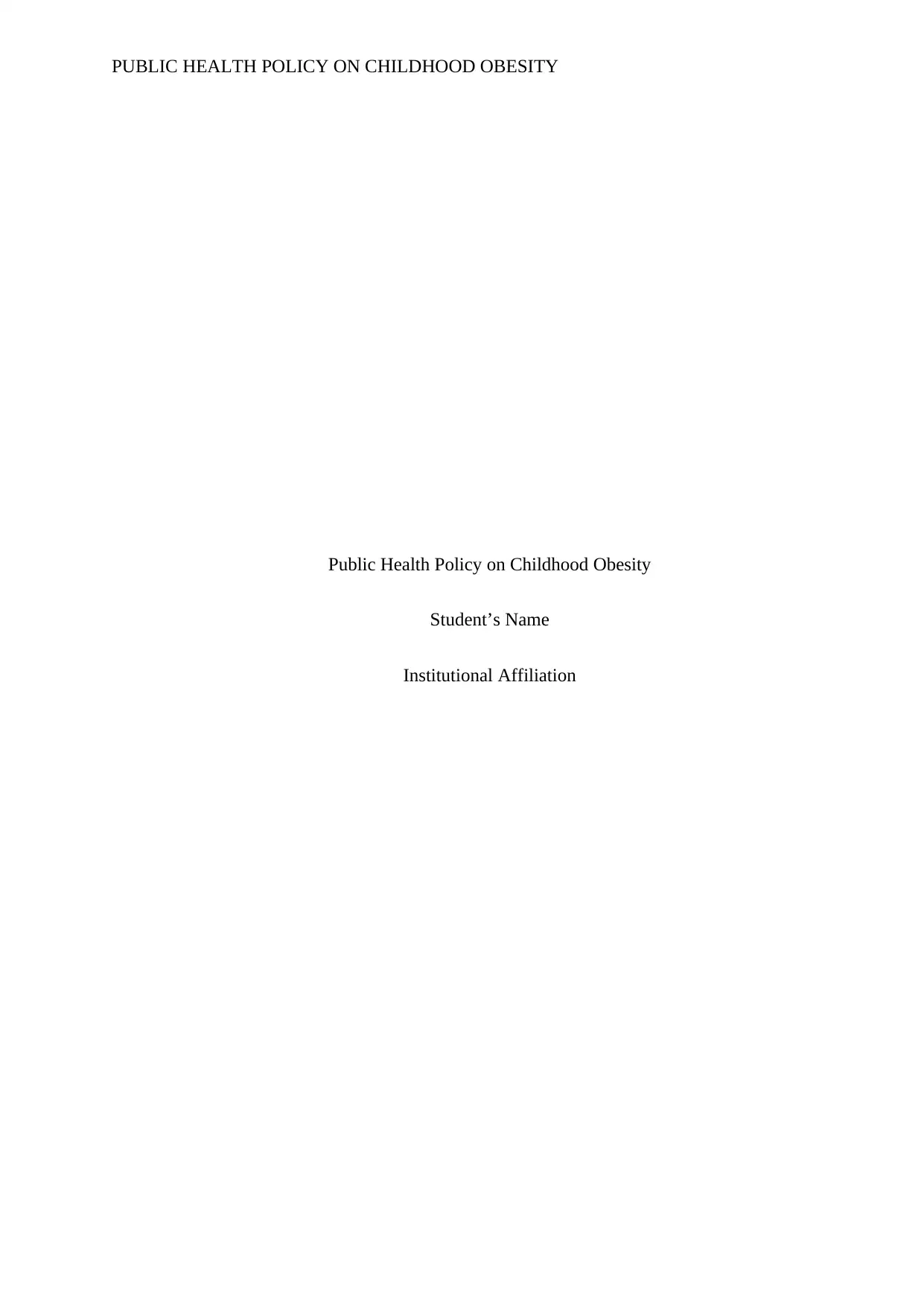
PUBLIC HEALTH POLICY ON CHILDHOOD OBESITY
Public Health Policy on Childhood Obesity
Student’s Name
Institutional Affiliation
Public Health Policy on Childhood Obesity
Student’s Name
Institutional Affiliation
Paraphrase This Document
Need a fresh take? Get an instant paraphrase of this document with our AI Paraphraser
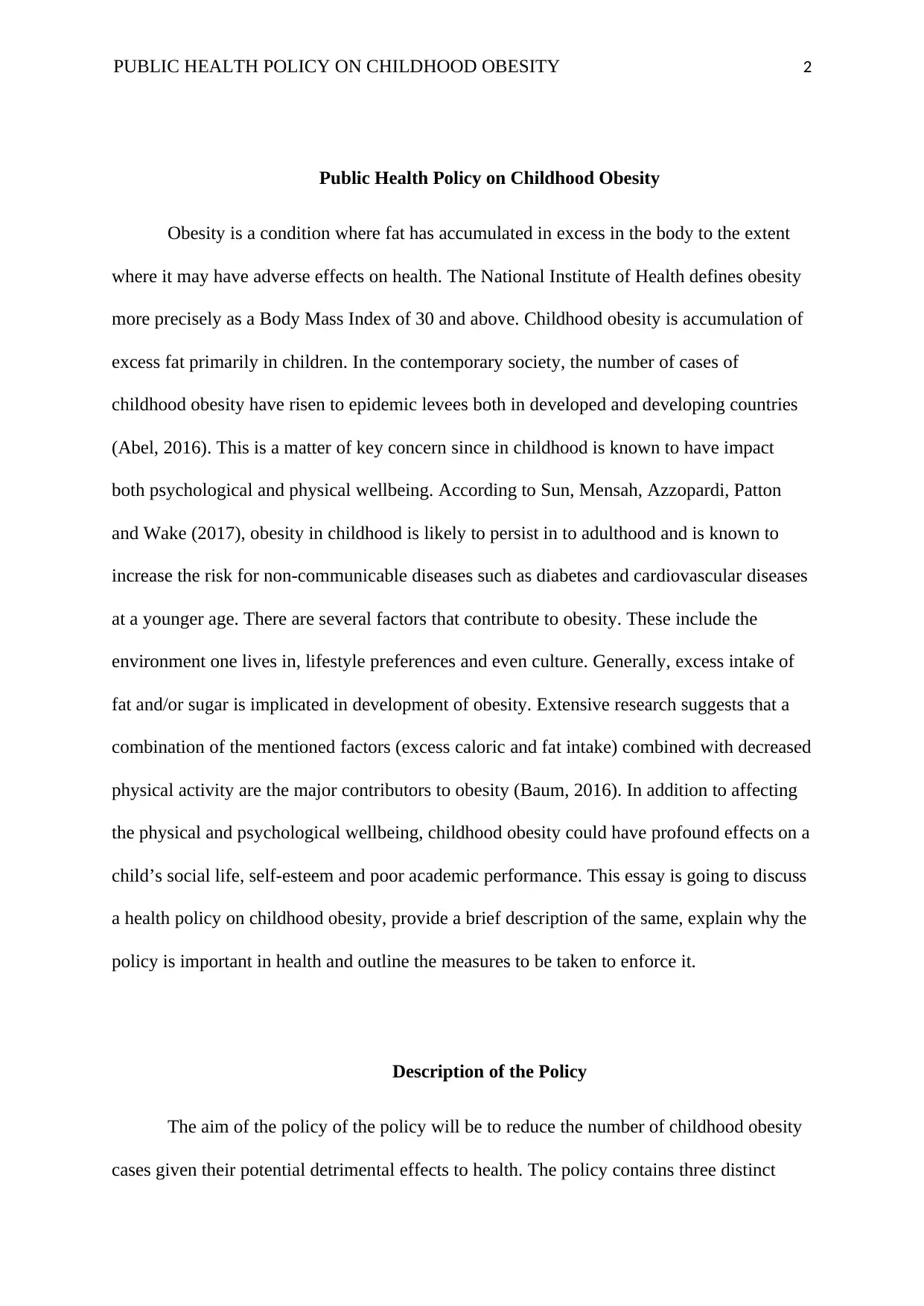
PUBLIC HEALTH POLICY ON CHILDHOOD OBESITY 2
Public Health Policy on Childhood Obesity
Obesity is a condition where fat has accumulated in excess in the body to the extent
where it may have adverse effects on health. The National Institute of Health defines obesity
more precisely as a Body Mass Index of 30 and above. Childhood obesity is accumulation of
excess fat primarily in children. In the contemporary society, the number of cases of
childhood obesity have risen to epidemic levees both in developed and developing countries
(Abel, 2016). This is a matter of key concern since in childhood is known to have impact
both psychological and physical wellbeing. According to Sun, Mensah, Azzopardi, Patton
and Wake (2017), obesity in childhood is likely to persist in to adulthood and is known to
increase the risk for non-communicable diseases such as diabetes and cardiovascular diseases
at a younger age. There are several factors that contribute to obesity. These include the
environment one lives in, lifestyle preferences and even culture. Generally, excess intake of
fat and/or sugar is implicated in development of obesity. Extensive research suggests that a
combination of the mentioned factors (excess caloric and fat intake) combined with decreased
physical activity are the major contributors to obesity (Baum, 2016). In addition to affecting
the physical and psychological wellbeing, childhood obesity could have profound effects on a
child’s social life, self-esteem and poor academic performance. This essay is going to discuss
a health policy on childhood obesity, provide a brief description of the same, explain why the
policy is important in health and outline the measures to be taken to enforce it.
Description of the Policy
The aim of the policy of the policy will be to reduce the number of childhood obesity
cases given their potential detrimental effects to health. The policy contains three distinct
Public Health Policy on Childhood Obesity
Obesity is a condition where fat has accumulated in excess in the body to the extent
where it may have adverse effects on health. The National Institute of Health defines obesity
more precisely as a Body Mass Index of 30 and above. Childhood obesity is accumulation of
excess fat primarily in children. In the contemporary society, the number of cases of
childhood obesity have risen to epidemic levees both in developed and developing countries
(Abel, 2016). This is a matter of key concern since in childhood is known to have impact
both psychological and physical wellbeing. According to Sun, Mensah, Azzopardi, Patton
and Wake (2017), obesity in childhood is likely to persist in to adulthood and is known to
increase the risk for non-communicable diseases such as diabetes and cardiovascular diseases
at a younger age. There are several factors that contribute to obesity. These include the
environment one lives in, lifestyle preferences and even culture. Generally, excess intake of
fat and/or sugar is implicated in development of obesity. Extensive research suggests that a
combination of the mentioned factors (excess caloric and fat intake) combined with decreased
physical activity are the major contributors to obesity (Baum, 2016). In addition to affecting
the physical and psychological wellbeing, childhood obesity could have profound effects on a
child’s social life, self-esteem and poor academic performance. This essay is going to discuss
a health policy on childhood obesity, provide a brief description of the same, explain why the
policy is important in health and outline the measures to be taken to enforce it.
Description of the Policy
The aim of the policy of the policy will be to reduce the number of childhood obesity
cases given their potential detrimental effects to health. The policy contains three distinct
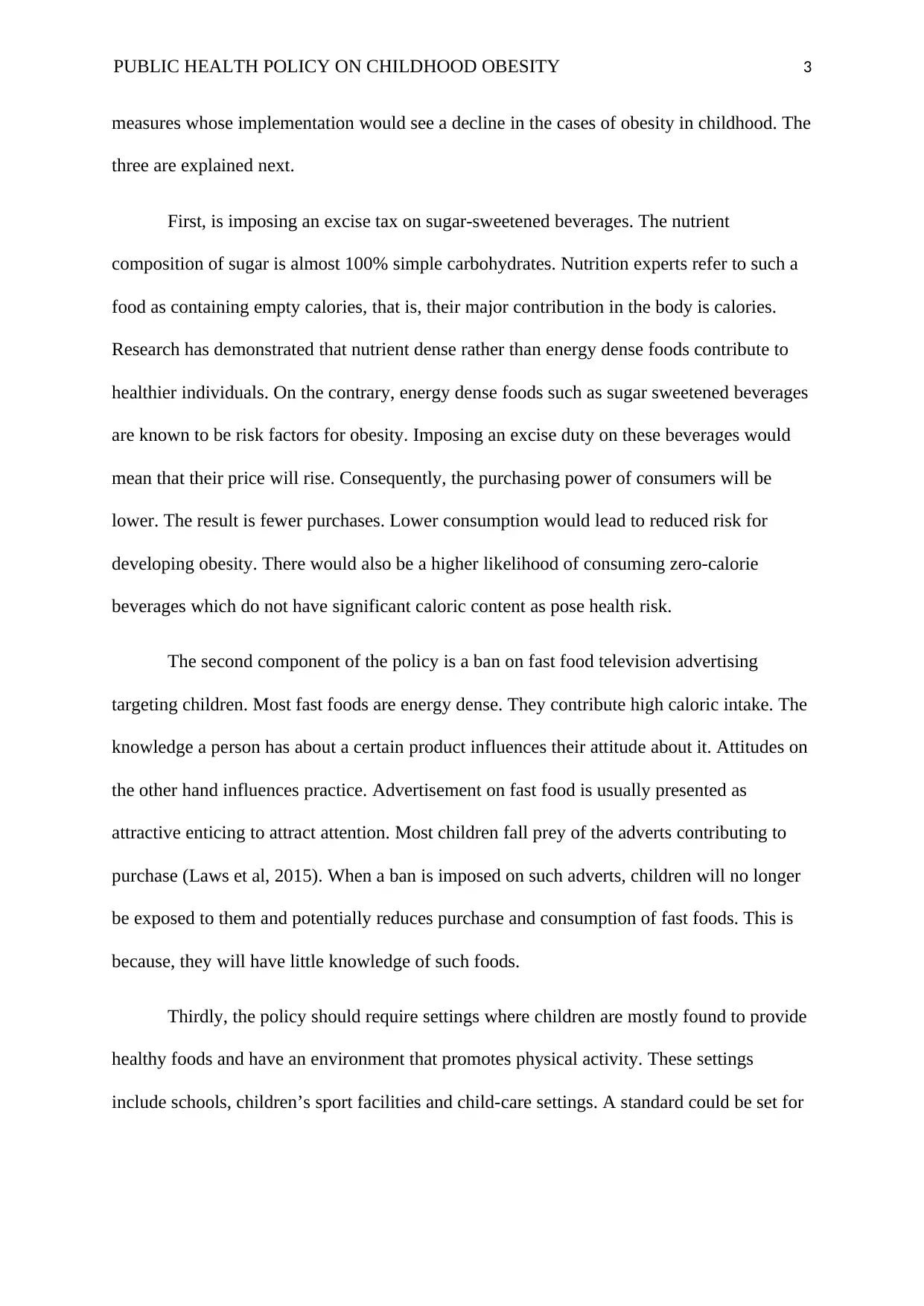
PUBLIC HEALTH POLICY ON CHILDHOOD OBESITY 3
measures whose implementation would see a decline in the cases of obesity in childhood. The
three are explained next.
First, is imposing an excise tax on sugar-sweetened beverages. The nutrient
composition of sugar is almost 100% simple carbohydrates. Nutrition experts refer to such a
food as containing empty calories, that is, their major contribution in the body is calories.
Research has demonstrated that nutrient dense rather than energy dense foods contribute to
healthier individuals. On the contrary, energy dense foods such as sugar sweetened beverages
are known to be risk factors for obesity. Imposing an excise duty on these beverages would
mean that their price will rise. Consequently, the purchasing power of consumers will be
lower. The result is fewer purchases. Lower consumption would lead to reduced risk for
developing obesity. There would also be a higher likelihood of consuming zero-calorie
beverages which do not have significant caloric content as pose health risk.
The second component of the policy is a ban on fast food television advertising
targeting children. Most fast foods are energy dense. They contribute high caloric intake. The
knowledge a person has about a certain product influences their attitude about it. Attitudes on
the other hand influences practice. Advertisement on fast food is usually presented as
attractive enticing to attract attention. Most children fall prey of the adverts contributing to
purchase (Laws et al, 2015). When a ban is imposed on such adverts, children will no longer
be exposed to them and potentially reduces purchase and consumption of fast foods. This is
because, they will have little knowledge of such foods.
Thirdly, the policy should require settings where children are mostly found to provide
healthy foods and have an environment that promotes physical activity. These settings
include schools, children’s sport facilities and child-care settings. A standard could be set for
measures whose implementation would see a decline in the cases of obesity in childhood. The
three are explained next.
First, is imposing an excise tax on sugar-sweetened beverages. The nutrient
composition of sugar is almost 100% simple carbohydrates. Nutrition experts refer to such a
food as containing empty calories, that is, their major contribution in the body is calories.
Research has demonstrated that nutrient dense rather than energy dense foods contribute to
healthier individuals. On the contrary, energy dense foods such as sugar sweetened beverages
are known to be risk factors for obesity. Imposing an excise duty on these beverages would
mean that their price will rise. Consequently, the purchasing power of consumers will be
lower. The result is fewer purchases. Lower consumption would lead to reduced risk for
developing obesity. There would also be a higher likelihood of consuming zero-calorie
beverages which do not have significant caloric content as pose health risk.
The second component of the policy is a ban on fast food television advertising
targeting children. Most fast foods are energy dense. They contribute high caloric intake. The
knowledge a person has about a certain product influences their attitude about it. Attitudes on
the other hand influences practice. Advertisement on fast food is usually presented as
attractive enticing to attract attention. Most children fall prey of the adverts contributing to
purchase (Laws et al, 2015). When a ban is imposed on such adverts, children will no longer
be exposed to them and potentially reduces purchase and consumption of fast foods. This is
because, they will have little knowledge of such foods.
Thirdly, the policy should require settings where children are mostly found to provide
healthy foods and have an environment that promotes physical activity. These settings
include schools, children’s sport facilities and child-care settings. A standard could be set for
⊘ This is a preview!⊘
Do you want full access?
Subscribe today to unlock all pages.

Trusted by 1+ million students worldwide

PUBLIC HEALTH POLICY ON CHILDHOOD OBESITY 4
such settings to ensure that this is maintained. When the environment promotes a healthy diet
and physical activity, the incidence of obesity lowers.
Importance of the Policy to Health
Obesity in childhood is one of the greatest t public health challenges faced in the 21st
century. It is a global concern affecting children in all regions of the world especially the low
and middle-income countries. The most affected areas are the urban settings. The prevalence
of childhood obesity has risen at an alarming rate over the years. According to Ludwig
(2018), over 41 million children below the age of five were obese in the year 2016. About
half of these lived in Asia while one quarter lived in Africa. There are several factors that
contribute to obesity and are generally categorized in to three. These are genetic factors, lack
of physical activity and unhealthy eating patterns. This policy comes in handy to reduce the
incidence of childhood obesity. This move can impact the health children positively in
several ways. Several of these benefits are going be discussed next.
First, is reduction in the number of childhood onset non-communicable diseases.
Childhood obesity has been implicated in development of chronic illnesses among children
(Shanahan et al, 2015). These diseases include type 2 diabetes, cardiovascular disease and
some types of cancers. These diseases were traditionally known to affect adults but
conditions such as obesity make them prevalent among children. When a child develops a
chronic disease, chances are that the disease will persist to adulthood. The cost of managing
the conditions can be high and most of a household’s oncome could be channelled to medical
bills. To make the matters worse, this will happen for a lifetime. This policy potentially
prevents such cases. It contributes to ensuring a healthy child and consequently a healthy
adult via prevention of the non-communicable diseases.
such settings to ensure that this is maintained. When the environment promotes a healthy diet
and physical activity, the incidence of obesity lowers.
Importance of the Policy to Health
Obesity in childhood is one of the greatest t public health challenges faced in the 21st
century. It is a global concern affecting children in all regions of the world especially the low
and middle-income countries. The most affected areas are the urban settings. The prevalence
of childhood obesity has risen at an alarming rate over the years. According to Ludwig
(2018), over 41 million children below the age of five were obese in the year 2016. About
half of these lived in Asia while one quarter lived in Africa. There are several factors that
contribute to obesity and are generally categorized in to three. These are genetic factors, lack
of physical activity and unhealthy eating patterns. This policy comes in handy to reduce the
incidence of childhood obesity. This move can impact the health children positively in
several ways. Several of these benefits are going be discussed next.
First, is reduction in the number of childhood onset non-communicable diseases.
Childhood obesity has been implicated in development of chronic illnesses among children
(Shanahan et al, 2015). These diseases include type 2 diabetes, cardiovascular disease and
some types of cancers. These diseases were traditionally known to affect adults but
conditions such as obesity make them prevalent among children. When a child develops a
chronic disease, chances are that the disease will persist to adulthood. The cost of managing
the conditions can be high and most of a household’s oncome could be channelled to medical
bills. To make the matters worse, this will happen for a lifetime. This policy potentially
prevents such cases. It contributes to ensuring a healthy child and consequently a healthy
adult via prevention of the non-communicable diseases.
Paraphrase This Document
Need a fresh take? Get an instant paraphrase of this document with our AI Paraphraser

PUBLIC HEALTH POLICY ON CHILDHOOD OBESITY 5
Secondly, is improved self-image and quality of life. Children with obesity usually
have a low self-esteem and do not like how they look. An impaired self esteem significantly
affects the quality of life. The child is likely to feel inferior to others and of little worth. This
may result in isolation, and in some cases depression. This is double tragedy since in addition
to having the obesity, the child has another psychological problem. According to Duckett and
Willcox (2015), the society also tends to criticize obese people and treat obesity as personal
choice. The general population assumes that obesity is a result of negligence or failure to eat
healthy foods and physical exercise. The environment is full of criticism which may make a
child feel like they don’t belong to it. This further aggravates the psychological problem the
child is undergoing. In some cases, especially near adolescent, the child may suffer from
eating disorders such as anorexia nervosa or bulimia nervosa (Cyril, Polonsky, Green, Agho,
and Renzaho, 2017). This further pose health problems. The policy again comes I handy to
prevent obesity and in extension reducing the cases of the above mentioned psychological
problems.
The third potential health benefit is achievement of an increase in healthy eating
patterns and improved physical activity. The body utilizes the nutrients from the food we eat
for provision of energy, growth and repair and other important bodily functions. When the
diet is healthy and contributes all the necessary nutrients, the body maintains optimum
functioning (Huang et al, 2015). The policy further ensures that a standard will be set to
ensure that the dietary needs of the children are put in to consideration. Children have their
own unique needs. In addition to promoting intake of healthy foods, the policy also ensures
physical activity. Physical activity and fitness has numerous health advantages to a child. For
instance, it is associated with a lower risk to non-communicable disease, improved immunity
and improved performance in class.
Secondly, is improved self-image and quality of life. Children with obesity usually
have a low self-esteem and do not like how they look. An impaired self esteem significantly
affects the quality of life. The child is likely to feel inferior to others and of little worth. This
may result in isolation, and in some cases depression. This is double tragedy since in addition
to having the obesity, the child has another psychological problem. According to Duckett and
Willcox (2015), the society also tends to criticize obese people and treat obesity as personal
choice. The general population assumes that obesity is a result of negligence or failure to eat
healthy foods and physical exercise. The environment is full of criticism which may make a
child feel like they don’t belong to it. This further aggravates the psychological problem the
child is undergoing. In some cases, especially near adolescent, the child may suffer from
eating disorders such as anorexia nervosa or bulimia nervosa (Cyril, Polonsky, Green, Agho,
and Renzaho, 2017). This further pose health problems. The policy again comes I handy to
prevent obesity and in extension reducing the cases of the above mentioned psychological
problems.
The third potential health benefit is achievement of an increase in healthy eating
patterns and improved physical activity. The body utilizes the nutrients from the food we eat
for provision of energy, growth and repair and other important bodily functions. When the
diet is healthy and contributes all the necessary nutrients, the body maintains optimum
functioning (Huang et al, 2015). The policy further ensures that a standard will be set to
ensure that the dietary needs of the children are put in to consideration. Children have their
own unique needs. In addition to promoting intake of healthy foods, the policy also ensures
physical activity. Physical activity and fitness has numerous health advantages to a child. For
instance, it is associated with a lower risk to non-communicable disease, improved immunity
and improved performance in class.
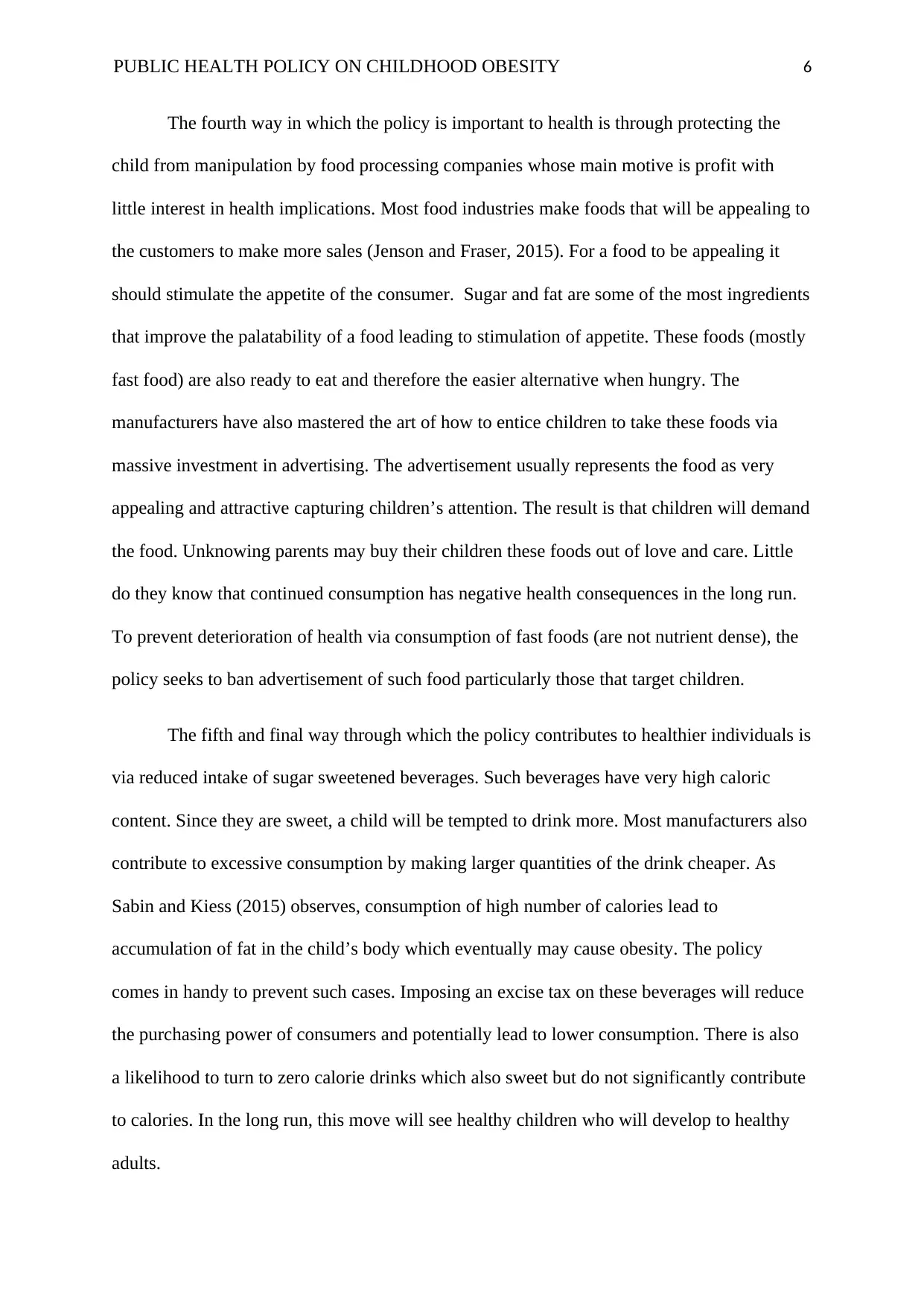
PUBLIC HEALTH POLICY ON CHILDHOOD OBESITY 6
The fourth way in which the policy is important to health is through protecting the
child from manipulation by food processing companies whose main motive is profit with
little interest in health implications. Most food industries make foods that will be appealing to
the customers to make more sales (Jenson and Fraser, 2015). For a food to be appealing it
should stimulate the appetite of the consumer. Sugar and fat are some of the most ingredients
that improve the palatability of a food leading to stimulation of appetite. These foods (mostly
fast food) are also ready to eat and therefore the easier alternative when hungry. The
manufacturers have also mastered the art of how to entice children to take these foods via
massive investment in advertising. The advertisement usually represents the food as very
appealing and attractive capturing children’s attention. The result is that children will demand
the food. Unknowing parents may buy their children these foods out of love and care. Little
do they know that continued consumption has negative health consequences in the long run.
To prevent deterioration of health via consumption of fast foods (are not nutrient dense), the
policy seeks to ban advertisement of such food particularly those that target children.
The fifth and final way through which the policy contributes to healthier individuals is
via reduced intake of sugar sweetened beverages. Such beverages have very high caloric
content. Since they are sweet, a child will be tempted to drink more. Most manufacturers also
contribute to excessive consumption by making larger quantities of the drink cheaper. As
Sabin and Kiess (2015) observes, consumption of high number of calories lead to
accumulation of fat in the child’s body which eventually may cause obesity. The policy
comes in handy to prevent such cases. Imposing an excise tax on these beverages will reduce
the purchasing power of consumers and potentially lead to lower consumption. There is also
a likelihood to turn to zero calorie drinks which also sweet but do not significantly contribute
to calories. In the long run, this move will see healthy children who will develop to healthy
adults.
The fourth way in which the policy is important to health is through protecting the
child from manipulation by food processing companies whose main motive is profit with
little interest in health implications. Most food industries make foods that will be appealing to
the customers to make more sales (Jenson and Fraser, 2015). For a food to be appealing it
should stimulate the appetite of the consumer. Sugar and fat are some of the most ingredients
that improve the palatability of a food leading to stimulation of appetite. These foods (mostly
fast food) are also ready to eat and therefore the easier alternative when hungry. The
manufacturers have also mastered the art of how to entice children to take these foods via
massive investment in advertising. The advertisement usually represents the food as very
appealing and attractive capturing children’s attention. The result is that children will demand
the food. Unknowing parents may buy their children these foods out of love and care. Little
do they know that continued consumption has negative health consequences in the long run.
To prevent deterioration of health via consumption of fast foods (are not nutrient dense), the
policy seeks to ban advertisement of such food particularly those that target children.
The fifth and final way through which the policy contributes to healthier individuals is
via reduced intake of sugar sweetened beverages. Such beverages have very high caloric
content. Since they are sweet, a child will be tempted to drink more. Most manufacturers also
contribute to excessive consumption by making larger quantities of the drink cheaper. As
Sabin and Kiess (2015) observes, consumption of high number of calories lead to
accumulation of fat in the child’s body which eventually may cause obesity. The policy
comes in handy to prevent such cases. Imposing an excise tax on these beverages will reduce
the purchasing power of consumers and potentially lead to lower consumption. There is also
a likelihood to turn to zero calorie drinks which also sweet but do not significantly contribute
to calories. In the long run, this move will see healthy children who will develop to healthy
adults.
⊘ This is a preview!⊘
Do you want full access?
Subscribe today to unlock all pages.

Trusted by 1+ million students worldwide
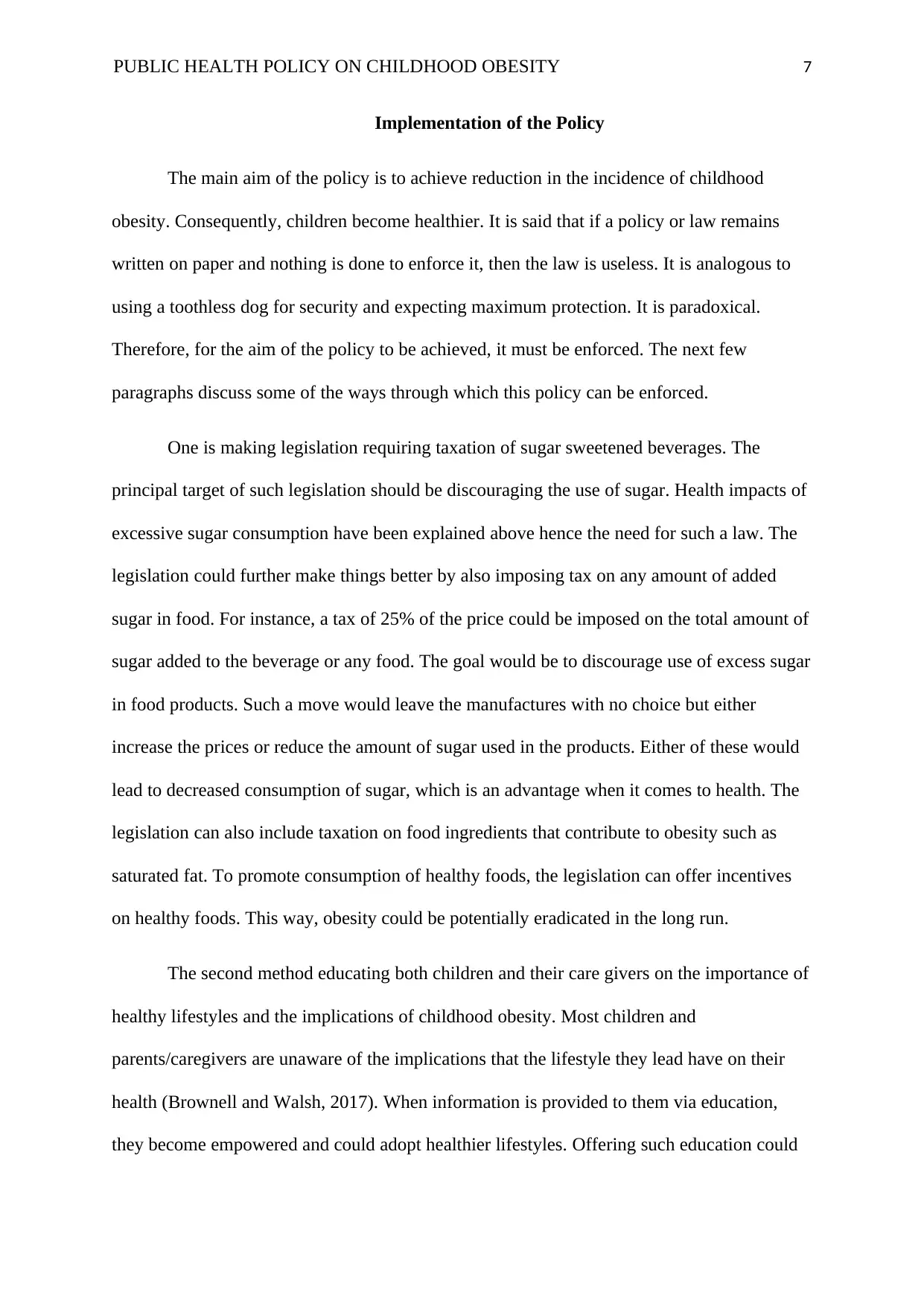
PUBLIC HEALTH POLICY ON CHILDHOOD OBESITY 7
Implementation of the Policy
The main aim of the policy is to achieve reduction in the incidence of childhood
obesity. Consequently, children become healthier. It is said that if a policy or law remains
written on paper and nothing is done to enforce it, then the law is useless. It is analogous to
using a toothless dog for security and expecting maximum protection. It is paradoxical.
Therefore, for the aim of the policy to be achieved, it must be enforced. The next few
paragraphs discuss some of the ways through which this policy can be enforced.
One is making legislation requiring taxation of sugar sweetened beverages. The
principal target of such legislation should be discouraging the use of sugar. Health impacts of
excessive sugar consumption have been explained above hence the need for such a law. The
legislation could further make things better by also imposing tax on any amount of added
sugar in food. For instance, a tax of 25% of the price could be imposed on the total amount of
sugar added to the beverage or any food. The goal would be to discourage use of excess sugar
in food products. Such a move would leave the manufactures with no choice but either
increase the prices or reduce the amount of sugar used in the products. Either of these would
lead to decreased consumption of sugar, which is an advantage when it comes to health. The
legislation can also include taxation on food ingredients that contribute to obesity such as
saturated fat. To promote consumption of healthy foods, the legislation can offer incentives
on healthy foods. This way, obesity could be potentially eradicated in the long run.
The second method educating both children and their care givers on the importance of
healthy lifestyles and the implications of childhood obesity. Most children and
parents/caregivers are unaware of the implications that the lifestyle they lead have on their
health (Brownell and Walsh, 2017). When information is provided to them via education,
they become empowered and could adopt healthier lifestyles. Offering such education could
Implementation of the Policy
The main aim of the policy is to achieve reduction in the incidence of childhood
obesity. Consequently, children become healthier. It is said that if a policy or law remains
written on paper and nothing is done to enforce it, then the law is useless. It is analogous to
using a toothless dog for security and expecting maximum protection. It is paradoxical.
Therefore, for the aim of the policy to be achieved, it must be enforced. The next few
paragraphs discuss some of the ways through which this policy can be enforced.
One is making legislation requiring taxation of sugar sweetened beverages. The
principal target of such legislation should be discouraging the use of sugar. Health impacts of
excessive sugar consumption have been explained above hence the need for such a law. The
legislation could further make things better by also imposing tax on any amount of added
sugar in food. For instance, a tax of 25% of the price could be imposed on the total amount of
sugar added to the beverage or any food. The goal would be to discourage use of excess sugar
in food products. Such a move would leave the manufactures with no choice but either
increase the prices or reduce the amount of sugar used in the products. Either of these would
lead to decreased consumption of sugar, which is an advantage when it comes to health. The
legislation can also include taxation on food ingredients that contribute to obesity such as
saturated fat. To promote consumption of healthy foods, the legislation can offer incentives
on healthy foods. This way, obesity could be potentially eradicated in the long run.
The second method educating both children and their care givers on the importance of
healthy lifestyles and the implications of childhood obesity. Most children and
parents/caregivers are unaware of the implications that the lifestyle they lead have on their
health (Brownell and Walsh, 2017). When information is provided to them via education,
they become empowered and could adopt healthier lifestyles. Offering such education could
Paraphrase This Document
Need a fresh take? Get an instant paraphrase of this document with our AI Paraphraser
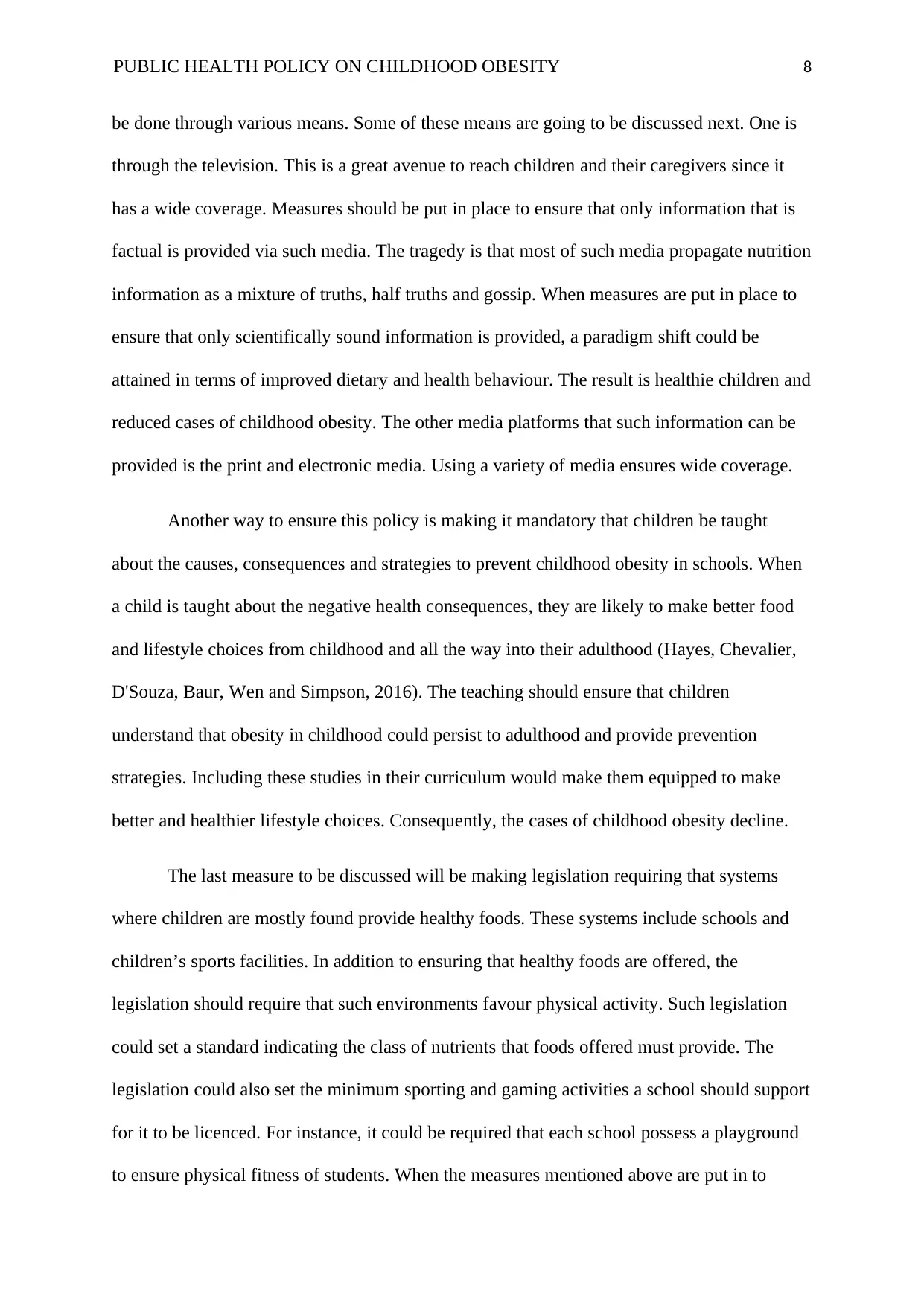
PUBLIC HEALTH POLICY ON CHILDHOOD OBESITY 8
be done through various means. Some of these means are going to be discussed next. One is
through the television. This is a great avenue to reach children and their caregivers since it
has a wide coverage. Measures should be put in place to ensure that only information that is
factual is provided via such media. The tragedy is that most of such media propagate nutrition
information as a mixture of truths, half truths and gossip. When measures are put in place to
ensure that only scientifically sound information is provided, a paradigm shift could be
attained in terms of improved dietary and health behaviour. The result is healthie children and
reduced cases of childhood obesity. The other media platforms that such information can be
provided is the print and electronic media. Using a variety of media ensures wide coverage.
Another way to ensure this policy is making it mandatory that children be taught
about the causes, consequences and strategies to prevent childhood obesity in schools. When
a child is taught about the negative health consequences, they are likely to make better food
and lifestyle choices from childhood and all the way into their adulthood (Hayes, Chevalier,
D'Souza, Baur, Wen and Simpson, 2016). The teaching should ensure that children
understand that obesity in childhood could persist to adulthood and provide prevention
strategies. Including these studies in their curriculum would make them equipped to make
better and healthier lifestyle choices. Consequently, the cases of childhood obesity decline.
The last measure to be discussed will be making legislation requiring that systems
where children are mostly found provide healthy foods. These systems include schools and
children’s sports facilities. In addition to ensuring that healthy foods are offered, the
legislation should require that such environments favour physical activity. Such legislation
could set a standard indicating the class of nutrients that foods offered must provide. The
legislation could also set the minimum sporting and gaming activities a school should support
for it to be licenced. For instance, it could be required that each school possess a playground
to ensure physical fitness of students. When the measures mentioned above are put in to
be done through various means. Some of these means are going to be discussed next. One is
through the television. This is a great avenue to reach children and their caregivers since it
has a wide coverage. Measures should be put in place to ensure that only information that is
factual is provided via such media. The tragedy is that most of such media propagate nutrition
information as a mixture of truths, half truths and gossip. When measures are put in place to
ensure that only scientifically sound information is provided, a paradigm shift could be
attained in terms of improved dietary and health behaviour. The result is healthie children and
reduced cases of childhood obesity. The other media platforms that such information can be
provided is the print and electronic media. Using a variety of media ensures wide coverage.
Another way to ensure this policy is making it mandatory that children be taught
about the causes, consequences and strategies to prevent childhood obesity in schools. When
a child is taught about the negative health consequences, they are likely to make better food
and lifestyle choices from childhood and all the way into their adulthood (Hayes, Chevalier,
D'Souza, Baur, Wen and Simpson, 2016). The teaching should ensure that children
understand that obesity in childhood could persist to adulthood and provide prevention
strategies. Including these studies in their curriculum would make them equipped to make
better and healthier lifestyle choices. Consequently, the cases of childhood obesity decline.
The last measure to be discussed will be making legislation requiring that systems
where children are mostly found provide healthy foods. These systems include schools and
children’s sports facilities. In addition to ensuring that healthy foods are offered, the
legislation should require that such environments favour physical activity. Such legislation
could set a standard indicating the class of nutrients that foods offered must provide. The
legislation could also set the minimum sporting and gaming activities a school should support
for it to be licenced. For instance, it could be required that each school possess a playground
to ensure physical fitness of students. When the measures mentioned above are put in to
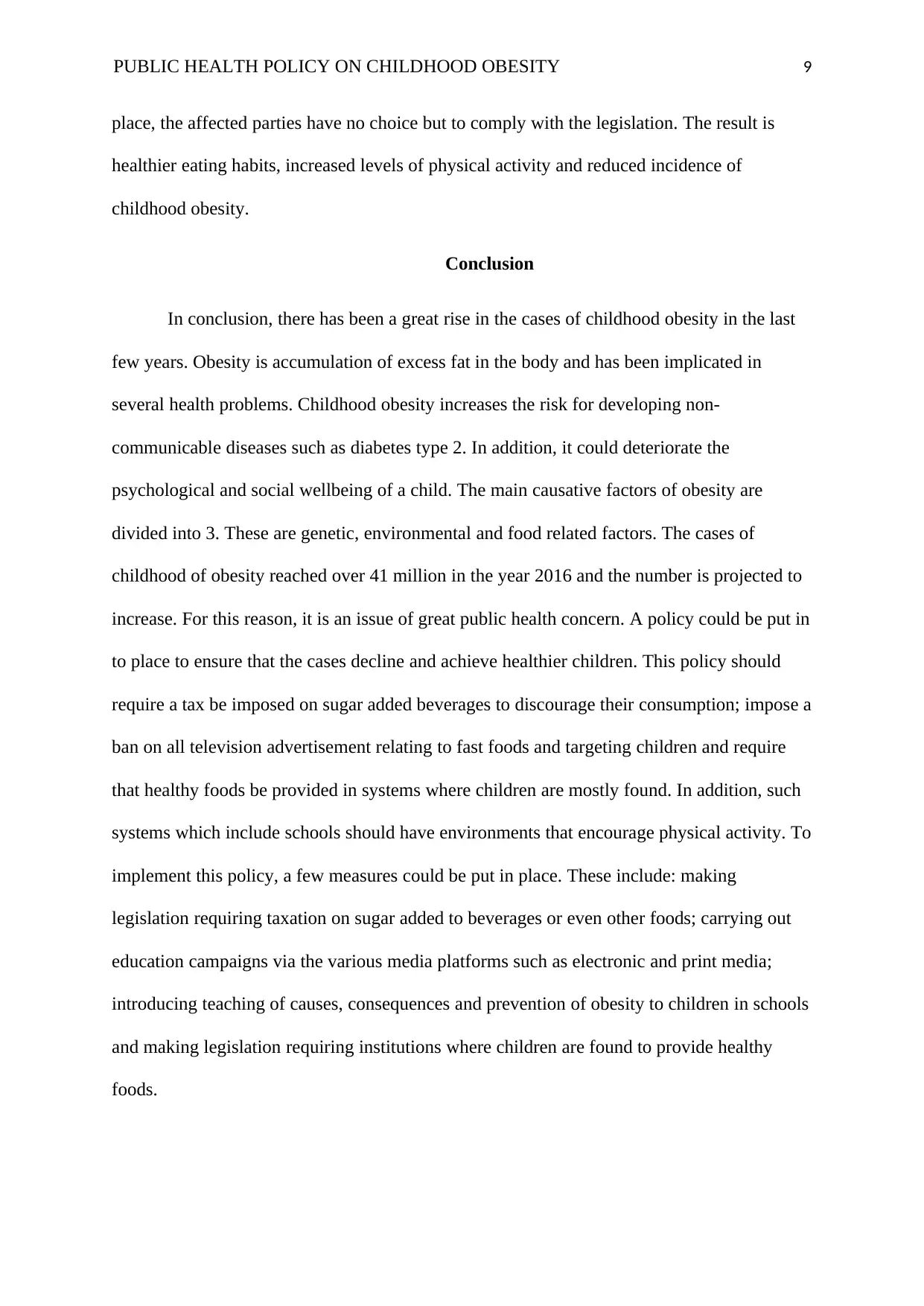
PUBLIC HEALTH POLICY ON CHILDHOOD OBESITY 9
place, the affected parties have no choice but to comply with the legislation. The result is
healthier eating habits, increased levels of physical activity and reduced incidence of
childhood obesity.
Conclusion
In conclusion, there has been a great rise in the cases of childhood obesity in the last
few years. Obesity is accumulation of excess fat in the body and has been implicated in
several health problems. Childhood obesity increases the risk for developing non-
communicable diseases such as diabetes type 2. In addition, it could deteriorate the
psychological and social wellbeing of a child. The main causative factors of obesity are
divided into 3. These are genetic, environmental and food related factors. The cases of
childhood of obesity reached over 41 million in the year 2016 and the number is projected to
increase. For this reason, it is an issue of great public health concern. A policy could be put in
to place to ensure that the cases decline and achieve healthier children. This policy should
require a tax be imposed on sugar added beverages to discourage their consumption; impose a
ban on all television advertisement relating to fast foods and targeting children and require
that healthy foods be provided in systems where children are mostly found. In addition, such
systems which include schools should have environments that encourage physical activity. To
implement this policy, a few measures could be put in place. These include: making
legislation requiring taxation on sugar added to beverages or even other foods; carrying out
education campaigns via the various media platforms such as electronic and print media;
introducing teaching of causes, consequences and prevention of obesity to children in schools
and making legislation requiring institutions where children are found to provide healthy
foods.
place, the affected parties have no choice but to comply with the legislation. The result is
healthier eating habits, increased levels of physical activity and reduced incidence of
childhood obesity.
Conclusion
In conclusion, there has been a great rise in the cases of childhood obesity in the last
few years. Obesity is accumulation of excess fat in the body and has been implicated in
several health problems. Childhood obesity increases the risk for developing non-
communicable diseases such as diabetes type 2. In addition, it could deteriorate the
psychological and social wellbeing of a child. The main causative factors of obesity are
divided into 3. These are genetic, environmental and food related factors. The cases of
childhood of obesity reached over 41 million in the year 2016 and the number is projected to
increase. For this reason, it is an issue of great public health concern. A policy could be put in
to place to ensure that the cases decline and achieve healthier children. This policy should
require a tax be imposed on sugar added beverages to discourage their consumption; impose a
ban on all television advertisement relating to fast foods and targeting children and require
that healthy foods be provided in systems where children are mostly found. In addition, such
systems which include schools should have environments that encourage physical activity. To
implement this policy, a few measures could be put in place. These include: making
legislation requiring taxation on sugar added to beverages or even other foods; carrying out
education campaigns via the various media platforms such as electronic and print media;
introducing teaching of causes, consequences and prevention of obesity to children in schools
and making legislation requiring institutions where children are found to provide healthy
foods.
⊘ This is a preview!⊘
Do you want full access?
Subscribe today to unlock all pages.

Trusted by 1+ million students worldwide
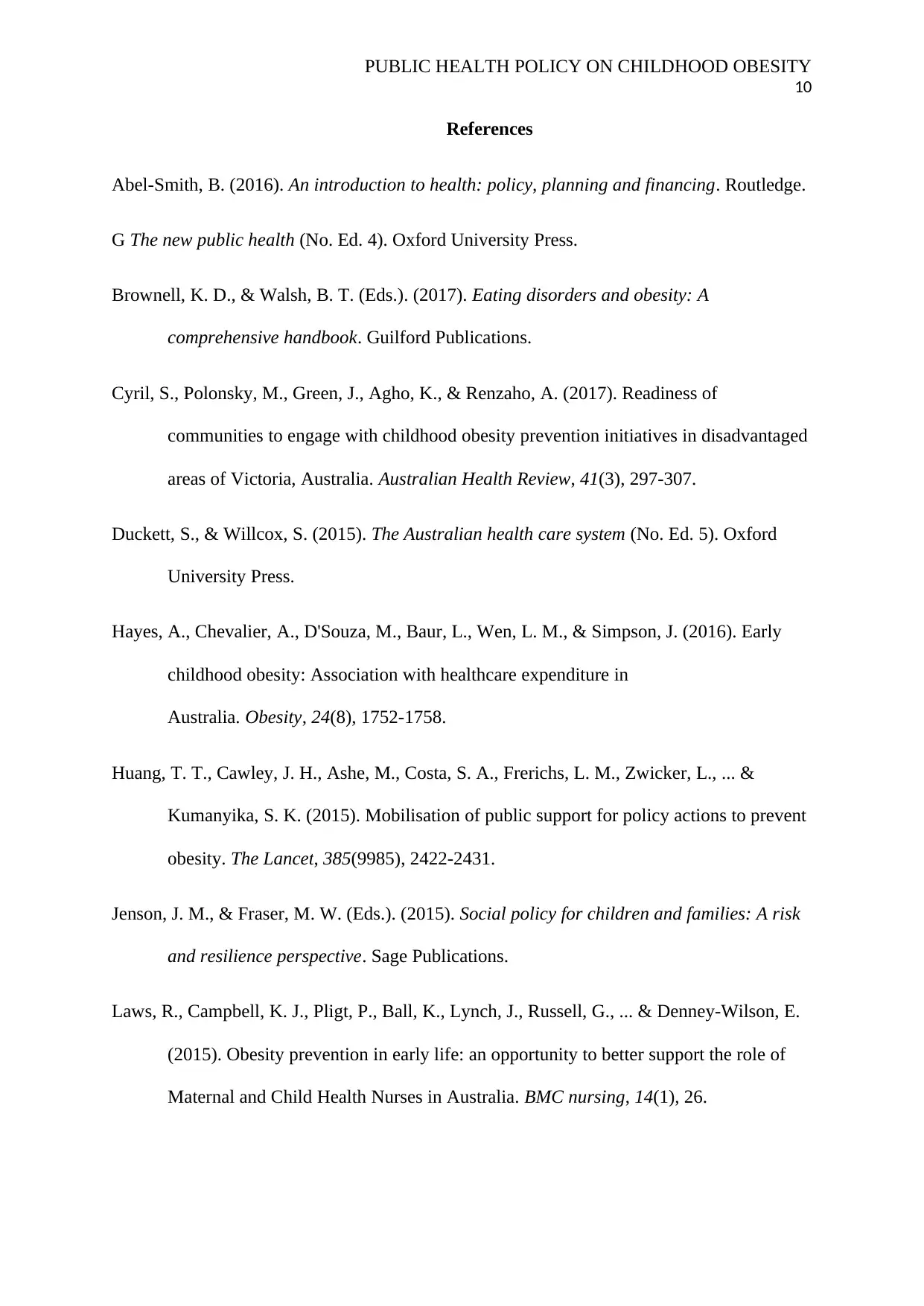
PUBLIC HEALTH POLICY ON CHILDHOOD OBESITY
10
References
Abel-Smith, B. (2016). An introduction to health: policy, planning and financing. Routledge.
G The new public health (No. Ed. 4). Oxford University Press.
Brownell, K. D., & Walsh, B. T. (Eds.). (2017). Eating disorders and obesity: A
comprehensive handbook. Guilford Publications.
Cyril, S., Polonsky, M., Green, J., Agho, K., & Renzaho, A. (2017). Readiness of
communities to engage with childhood obesity prevention initiatives in disadvantaged
areas of Victoria, Australia. Australian Health Review, 41(3), 297-307.
Duckett, S., & Willcox, S. (2015). The Australian health care system (No. Ed. 5). Oxford
University Press.
Hayes, A., Chevalier, A., D'Souza, M., Baur, L., Wen, L. M., & Simpson, J. (2016). Early
childhood obesity: Association with healthcare expenditure in
Australia. Obesity, 24(8), 1752-1758.
Huang, T. T., Cawley, J. H., Ashe, M., Costa, S. A., Frerichs, L. M., Zwicker, L., ... &
Kumanyika, S. K. (2015). Mobilisation of public support for policy actions to prevent
obesity. The Lancet, 385(9985), 2422-2431.
Jenson, J. M., & Fraser, M. W. (Eds.). (2015). Social policy for children and families: A risk
and resilience perspective. Sage Publications.
Laws, R., Campbell, K. J., Pligt, P., Ball, K., Lynch, J., Russell, G., ... & Denney-Wilson, E.
(2015). Obesity prevention in early life: an opportunity to better support the role of
Maternal and Child Health Nurses in Australia. BMC nursing, 14(1), 26.
10
References
Abel-Smith, B. (2016). An introduction to health: policy, planning and financing. Routledge.
G The new public health (No. Ed. 4). Oxford University Press.
Brownell, K. D., & Walsh, B. T. (Eds.). (2017). Eating disorders and obesity: A
comprehensive handbook. Guilford Publications.
Cyril, S., Polonsky, M., Green, J., Agho, K., & Renzaho, A. (2017). Readiness of
communities to engage with childhood obesity prevention initiatives in disadvantaged
areas of Victoria, Australia. Australian Health Review, 41(3), 297-307.
Duckett, S., & Willcox, S. (2015). The Australian health care system (No. Ed. 5). Oxford
University Press.
Hayes, A., Chevalier, A., D'Souza, M., Baur, L., Wen, L. M., & Simpson, J. (2016). Early
childhood obesity: Association with healthcare expenditure in
Australia. Obesity, 24(8), 1752-1758.
Huang, T. T., Cawley, J. H., Ashe, M., Costa, S. A., Frerichs, L. M., Zwicker, L., ... &
Kumanyika, S. K. (2015). Mobilisation of public support for policy actions to prevent
obesity. The Lancet, 385(9985), 2422-2431.
Jenson, J. M., & Fraser, M. W. (Eds.). (2015). Social policy for children and families: A risk
and resilience perspective. Sage Publications.
Laws, R., Campbell, K. J., Pligt, P., Ball, K., Lynch, J., Russell, G., ... & Denney-Wilson, E.
(2015). Obesity prevention in early life: an opportunity to better support the role of
Maternal and Child Health Nurses in Australia. BMC nursing, 14(1), 26.
Paraphrase This Document
Need a fresh take? Get an instant paraphrase of this document with our AI Paraphraser
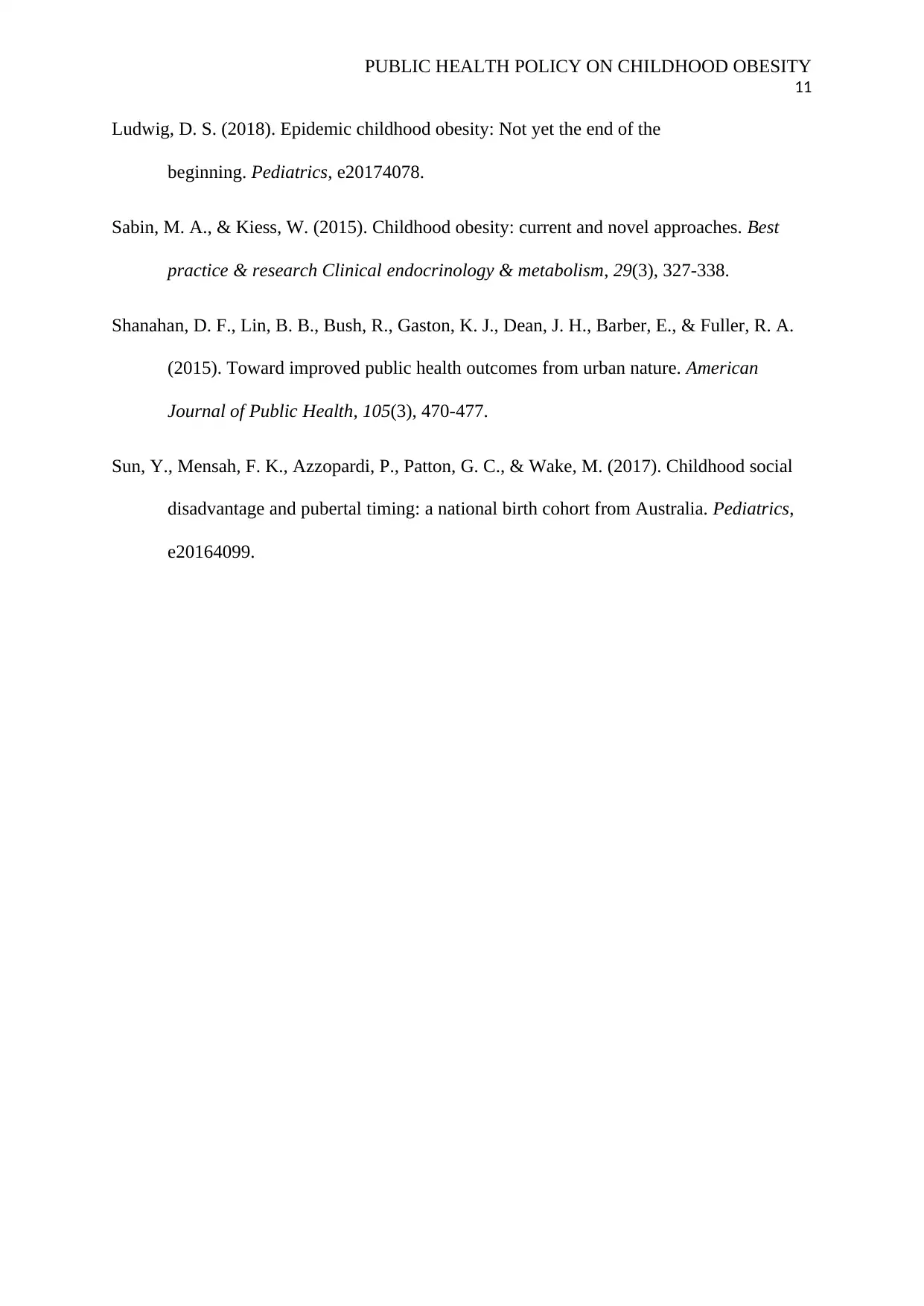
PUBLIC HEALTH POLICY ON CHILDHOOD OBESITY
11
Ludwig, D. S. (2018). Epidemic childhood obesity: Not yet the end of the
beginning. Pediatrics, e20174078.
Sabin, M. A., & Kiess, W. (2015). Childhood obesity: current and novel approaches. Best
practice & research Clinical endocrinology & metabolism, 29(3), 327-338.
Shanahan, D. F., Lin, B. B., Bush, R., Gaston, K. J., Dean, J. H., Barber, E., & Fuller, R. A.
(2015). Toward improved public health outcomes from urban nature. American
Journal of Public Health, 105(3), 470-477.
Sun, Y., Mensah, F. K., Azzopardi, P., Patton, G. C., & Wake, M. (2017). Childhood social
disadvantage and pubertal timing: a national birth cohort from Australia. Pediatrics,
e20164099.
11
Ludwig, D. S. (2018). Epidemic childhood obesity: Not yet the end of the
beginning. Pediatrics, e20174078.
Sabin, M. A., & Kiess, W. (2015). Childhood obesity: current and novel approaches. Best
practice & research Clinical endocrinology & metabolism, 29(3), 327-338.
Shanahan, D. F., Lin, B. B., Bush, R., Gaston, K. J., Dean, J. H., Barber, E., & Fuller, R. A.
(2015). Toward improved public health outcomes from urban nature. American
Journal of Public Health, 105(3), 470-477.
Sun, Y., Mensah, F. K., Azzopardi, P., Patton, G. C., & Wake, M. (2017). Childhood social
disadvantage and pubertal timing: a national birth cohort from Australia. Pediatrics,
e20164099.
1 out of 11
Related Documents
Your All-in-One AI-Powered Toolkit for Academic Success.
+13062052269
info@desklib.com
Available 24*7 on WhatsApp / Email
![[object Object]](/_next/static/media/star-bottom.7253800d.svg)
Unlock your academic potential
Copyright © 2020–2026 A2Z Services. All Rights Reserved. Developed and managed by ZUCOL.





